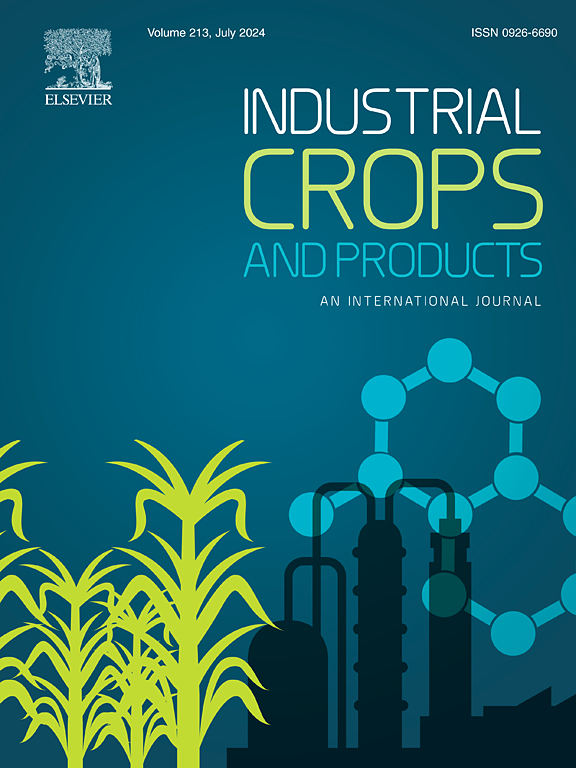Essential oils under stress: How drought and salinity shape the physiological and biochemical profile of Thymus ×citriodorus
IF 5.6
1区 农林科学
Q1 AGRICULTURAL ENGINEERING
引用次数: 0
Abstract
In the face of escalating environmental pressures, gaining insights into how medicinal plants adapt to adverse abiotic stresses is crucial for optimizing their growth and bioactive compound production. This study investigates how drought (40 % soil water capacity), salinity (120 mM NaCl), and their combination influence the growth, physiology, and biochemical responses of Thymus × citriodorus. Morphological analyses revealed reductions in shoot and root parameters across all stress treatments, with the most pronounced declines observed under combined stress. Chlorophyll, carotenoids and relative water content, were reduced under stressed treatments but mainly under salt and combined stresses. In response to these stresses, proline, soluble sugars, and total polyphenols increased significantly, reflecting enhanced osmotic adjustment and protective antioxidant mechanisms, while elevated hydrogen peroxide levels across all stress treatments, signalled intensified oxidative stress. Interestingly, antioxidant capacity significantly decreased under stress conditions, suggesting that the oxidative load exceeded the plant’s antioxidative defences. Essential oil content peaked in unstressed plants (0.45 mL/100 g DW), while GC-MS analysis identified 17 volatile compounds, such as geraniol, geranial, and neral that exhibited substantial fluctuations, indicating stress induced adjustments in secondary metabolism tied to their defensive roles. While the plant exhibits a degree of tolerance to drought, salinity alone or in combination with drought severely compromises overall productivity. These findings provide comprehensive insights into how T. × citriodorus modulates growth and biochemical pathways under abiotic stress, offering practical implications for improving the resilience and agricultural potential of medicinal plants in regions prone to abiotic stress.

压力下的精油:干旱和盐度如何塑造胸腺的生理生化特征×citriodorus
面对不断升级的环境压力,深入了解药用植物如何适应不利的非生物胁迫对于优化其生长和生物活性化合物的生产至关重要。研究了干旱(40 %土壤水量)、盐度(120 mM NaCl)及其组合对麝香草× 的生长、生理生化反应的影响。形态分析表明,在所有胁迫处理下,茎和根参数均有所下降,其中复合胁迫下下降最为明显。叶绿素、类胡萝卜素和相对含水量在胁迫处理下均有所降低,但以盐胁迫和复合胁迫为主。在这些胁迫下,脯氨酸、可溶性糖和总多酚显著增加,反映了渗透调节和保护性抗氧化机制的增强,而在所有胁迫处理中,过氧化氢水平升高表明氧化应激加剧。有趣的是,在应激条件下,抗氧化能力显著下降,表明氧化负荷超过了植物的抗氧化防御。精油含量在未受胁迫的植物中达到峰值(0.45 mL/100 g DW),而GC-MS分析鉴定出17种挥发性化合物,如香叶醇、香叶醇和天竺葵,表现出大幅波动,表明应激诱导的次级代谢调整与其防御作用相关。虽然该植物对干旱表现出一定程度的耐受性,但盐度单独或与干旱结合严重损害了整体生产力。这些发现对T. x citriodorus在非生物胁迫下如何调节生长和生化途径提供了全面的见解,为提高非生物胁迫易发地区药用植物的恢复力和农业潜力提供了实际意义。
本文章由计算机程序翻译,如有差异,请以英文原文为准。
求助全文
约1分钟内获得全文
求助全文
来源期刊

Industrial Crops and Products
农林科学-农业工程
CiteScore
9.50
自引率
8.50%
发文量
1518
审稿时长
43 days
期刊介绍:
Industrial Crops and Products is an International Journal publishing academic and industrial research on industrial (defined as non-food/non-feed) crops and products. Papers concern both crop-oriented and bio-based materials from crops-oriented research, and should be of interest to an international audience, hypothesis driven, and where comparisons are made statistics performed.
 求助内容:
求助内容: 应助结果提醒方式:
应助结果提醒方式:


